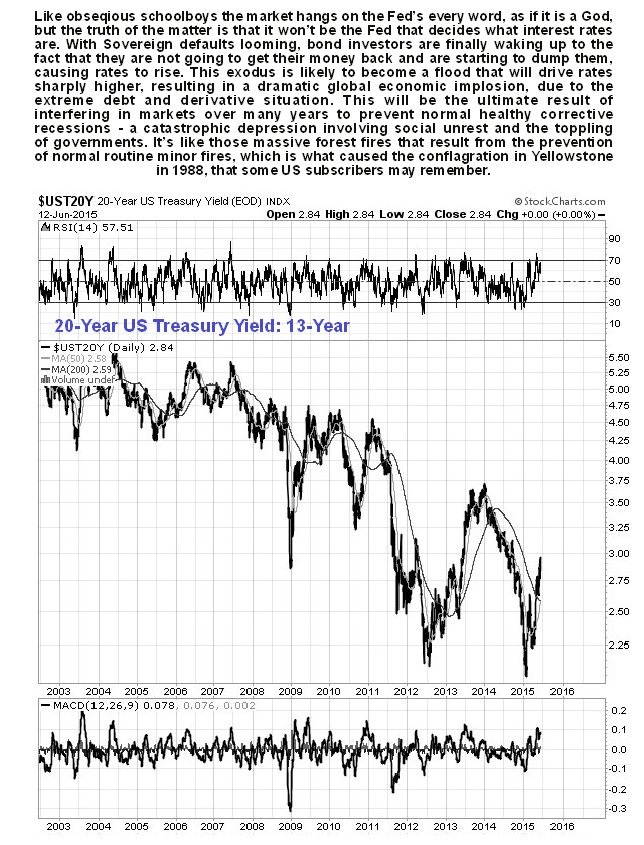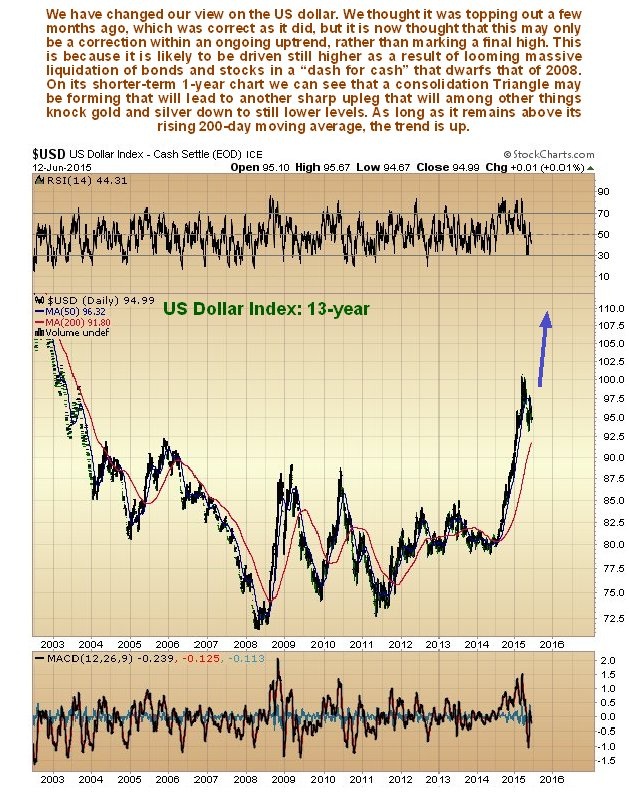Bomb Bombshell…
DEFLATION RULES... because periodic recessions, necessary to rebalance the economy after periods of growth, cannot be put off forever by the short-term expedient of printing money. The result of such corrupt and evasive practices is that the deflationary forces build up to catastrophic and overwhelming proportions leading to economic collapse and depression. This is the point that we have arrived at now. Why can’t governments keep the game going indefinitely by printing more and more money? – because the debt grows and grows until it becomes apparent even to dull-witted bond / Treasury holders that they are never going to get their money back, so they start selling and the selling snowballs into an avalanche, driving interest rates through the roof. Bond and stock markets crash and the economy sinks into a dangerously deep depression, all because governments stubbornly refused to do the right thing all along, and interfered with and obstructed normal market forces, culminating in their idiotic and ruinous QE, ZIRP and now even NIRP.
Of course, the mainstream financial media are trying to portray the recent trend of rising interest rates as a sign that the economy is recovering, saying that it is increasing demand in the economy that is driving rates up. If this is so then why is the Baltic Dry Index, which is a measure of shipping rates, at rock bottom depression levels, and why are commodity prices near to their 2008 – 2009 crash lows?? No – the reason that rates are going up is that bond holders have finally seen the writing on the wall and woken up to the fact that governments around the world not only have no intention of honoring their debts, but are incapable of doing so, even if they wanted to, so why should they hold on to piles of ultimately worthless paper that don’t even yield anything in the here and now? This is why bond and Treasury prices have been dropping, and notwithstanding any short-term bounce to alleviate the short-term oversold condition, look set to go into a self-feeding downward spiral that will drive rates sharply higher, turning the Fed into an impotent bystander. All this looks set to happen with a rapidity that will surprise many people and catch them off guard, particularly those who complacently assume that the long uptrend in many stockmarkets is set to continue forever.
Alright, so what is set to happen and what will drop and what will go up? Bond, commodity and stockmarkets look set to crash, with the rising rates associated with falling bond prices ripping the rug out from under the stockmarket. A wild “dash for cash” would be the result of this that will drive the dollar to possibly dizzying heights, like 2008 on steroids. Eventually, after this “swansong” rally, the dollar will crash and burn, especially when China – Russia roll out their gold backed new world reserve currency, an event which could trigger a war. Gold and silver will likely get caught up in this maelstrom and drop to new lows, despite imminent positive seasonal factors, but will later emerge into spectacular bullmarkets, and it will be important for any investors wanting to buy physical gold and silver to aim to do so ahead of the crash bottom, because after the turn it will be almost impossible to buy physical, and also to keep in mind that governments can be expected to pass laws enabling them to forcibly steal your gold and silver – so give some thought to where you are going to store it.
Our tactics therefore involve 2 main planks – cash: the US dollar, and bear ETFs, in bonds on any bounce and in stocks immediately. The more daring may consider out of the money Puts, and you should “swing until you hit”, rolling into the next series until the plunge occurs. We hold off buying the Precious Metals sector until this last takedown has run its course, which will likely see gold drop to the $850 - $1000 area and silver to about $10. Then we come out “guns blazing” because the ensuing rally in gold and silver is likely to be spectacular, dwarfing what occurred in the late 70’s.
Let’s now quickly review some relevant charts.
We start with the 13-year chart for TLT, which is a good long T-Bond proxy. On this chart we see that despite the recent sharp drop, predicted on the site in the last Bond Market update, it still hasn’t broken down from its long-term uptrend. The later stages of its bullmarket advance were of course fuelled by ZIRP, but since interest rates can’t go much below 0, it is pretty obvious that this bullmarket has run its course, especially with rates looking set to rise in the face of Sovereign defaults. It is therefore expected to break down from this long-term uptrend to enter a bearmarket.
Next yields. Yields have risen sharply over the past couple of months as bonds have dropped in price. This is a process that looks set to continue, even if we see a short-term pause, and to accelerate…
The Baltic Dry Index, which measures shipping rates, is at rock bottom economic depression levels, indicating that global trade is weak and contracting, with the risk of more trade wars. This is a sign of deflation at large…
Likewise the commodity index chart shown below hardly indicates a robust world economy…
The US dollar is now at a very interesting juncture. In March its parabolic uptrend peaked and it burned out temporarily. At the time and soon after we had thought that it was done, and would go on to drop away, but given the prospect for a mass exodus from bonds and stocks, it looks set to become the beneficiary of a massive “dash for cash” that could drive another strong dollar rally. Technically, this is certainly possible as it is still above a rising 200-day moving average which means that arguably its trend is still up, and the reaction of recent months has allowed its earlier overbought condition to completely unwind.
Looking at recent dollar action in more detail on its 1-year chart (dollar index) we see that a consolidation Triangle may be forming above its rising 200-day moving average, which is now coming into play and could power another major upleg from here. This of course would be bad news for commodity prices, including gold and silver which would be tipped into another downleg.
Bondmarkets are expected to enter a confirmed a bearmarket soon, the first for many years, triggered by a wave of selling ahead of Sovereign defaults leading to more steep rises in interest rates. This will cause bloated stockmarkets to crash and commodities to drop further. The torrent of funds liberated as a result of this selling can be expected to flow into the US dollar, sending it sharply higher again. If this scenario prevails then the way to go for investors is cash and bear ETFs, with the eventual aim of switching into Precious Metal sector investments as they approach downside targets, for the ensuing rally in gold and silver should be massive. Physical metal purchases should be made ahead of the bottom, as physical will likely be very hard to source hard after the turn.
********
Courtesy of http://www.clivemaund.com/























